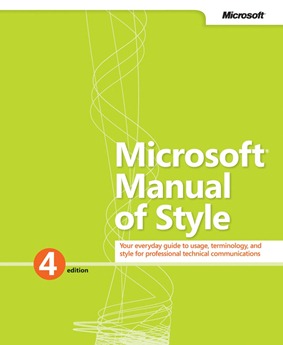Reader review: Microsoft Manual of Style, Fourth Edition
 Greetings. Over at InfoWorld Neil McAllister has written a review titled “Why Microsoft developers need a style guide” that describes how the Microsoft Manual of Style, Fourth Edition is a great tool for software developers.
Greetings. Over at InfoWorld Neil McAllister has written a review titled “Why Microsoft developers need a style guide” that describes how the Microsoft Manual of Style, Fourth Edition is a great tool for software developers.
His review begins like this:
“I usually get some flak from readers whenever I suggest that software developers can learn lessons from Microsoft. Not everyone thinks Microsoft is a role model. Nonetheless, I maintain you'd be hard-pressed to find another company outside Redmond that thinks more seriously and deeply about the practices and processes of software development.
Case in point: the new fourth edition of the Microsoft Manual of Style, which crossed my desk last week. The Microsoft Manual of Style is a style guide for writers. Its goal is to maintain consistency in published writing by settling various niggling points of style and usage. For example, is it ‘e-mail’ or ‘email’? Do you capitalize ‘Web’? Is a CD-ROM a ‘disc’ or a ‘disk’? And so on.
Lots of publishers maintain internal style guides. Most magazines have one. InfoWorld has one. What makes Microsoft's style guide interesting, however, is that it applies to all kinds of official communications. Its intended audience includes not just the authors of manuals, articles, and advertising, but the designers and developers who create Microsoft software.
Why do software developers need a style guide? As it turns out, for more reasons than you might think. The manual covers all the typical editorial suggestions, such as using consistent terminology and style, favoring active over passive voice, and avoiding sexist language and excessive jargon. But it also includes a wealth of tips that are unique to the modern discipline of software design.”
And he closes his review with the following:
“More often than not, however, the Microsoft Manual of Style offers sound advice that can be beneficial to any software development organization, large or small. Its advice covers not just user-facing text but also source code comments and SDK and API documentation. And consider this: Independent developers who master Microsoft's linguistic advice gain one more hedge against competition from offshore outsourcing.
The book's greatest value, however, is simply that it can get programmers thinking about language in the context of software development. That's something the industry could use more of. After all, in an information economy, how you communicate information is at least as important as how you process it.”
And in-between he makes lots of interesting points about the importance of language standards for those creating software.